L.A.’s free summer soundtrack
July 3, 2014
From Balinese gamelan music to mariachi spectaculars, jazzy interludes to multicultural pop, Los Angeles County is about to start grooving to the summertime beat of free music.
Nearly 60 free concerts are scheduled this season at parks and other public venues throughout Los Angeles County. Funded by the Board of Supervisors and sponsored by the county Arts Commission, the performances promise an incredible diversity of musical genres that give new meaning to the refrain “hot town, summer in the city.” Artists for just this month alone include Hound Dog Dave and the Mel-Tones, the UnderCover Girls, Samba Society and Julio Montero and the Far South Trio. The lineup of concerts in the 3rd District is here, featuring performances at El Cariso Regional Park, the Los Angeles County Museum of Art, Kings Road Park in West Hollywood and San Fernando Recreation Park. A schedule of what’s going on countywide is here.
And because this is Southern California, there’s an added bonus: the music doesn’t have to stop till October 19, when the Mariachi Divas bring down the curtain on the summer free concert season at Heritage Plaza Park in Covina.
Posted 7/3/14
Picking up pace to protect kids
July 3, 2014
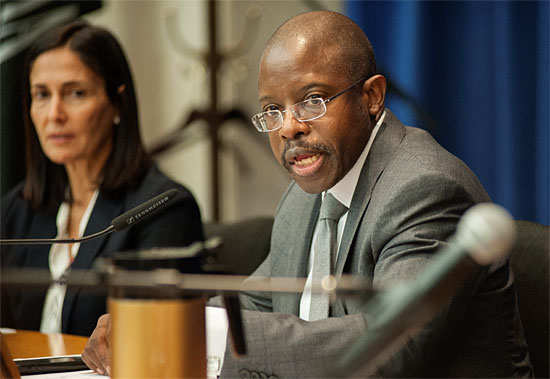
David Sanders and Leslie Gilbert-Lurie are moving from the blue ribbon panel to a new transition team.
As Los Angeles County prepares to hire its first-ever child protection czar to lead an ambitious new oversight program, efforts to build that system accelerated this week with the appointment of a high-profile transition team to help get the initiative off the ground.
The nine-member team approved by the Board of Supervisors on Tuesday includes a mix of newcomers as well as several veterans of the Blue Ribbon Commission on Child Protection, which earlier this year urged the county to create an Office of Child Protection as the cornerstone of a wide-ranging package of reforms.
The transition team is charged with sifting through more than 40 of the commission’s recommendations to help prioritize which the county should implement first.
David Sanders, who chaired the blue ribbon panel and also will be a member of the transition team, said a big part of the interim group’s job will be to make sure that proposed reforms receive the necessary follow-through.
“We really have concerns about that…We didn’t want to just add a new series of recommendations,” said Sanders, a former head of the county’s Department of Children and Family Services who now is an executive vice president of the Seattle-based Casey Family Programs.
The team, which is meant to disband once the Office of Child Protection is up and running, will also help recruit and shape the job description for the person who will run the new agency.
In addition, the transition panel is charged with making some critical assessments in the days and weeks ahead. For one thing, it will evaluate the performance—and potential for expansion—of the county’s network of so-called medical hubs, where the physical health of youngsters coming into the system is evaluated. And it will wade into the sometimes contentious issue of how best to use county nurses to help social workers conduct frontline investigations of suspected child abuse.
The transition team will provide monthly updates to the Board of Supervisors beginning on August 5.
The reforms now being implemented come after the horrific death last year of Gabriel Fernandez, an 8-year-old Palmdale boy was left by social workers in the care of his mother and her boyfriend despite multiple reports of abuse, neglect and torture.
Even before the blue ribbon commission began its work, current DCFS head Philip Browning had embarked on a reform mission from within the department, including expanded training, a plan to hire more staff and reduce caseloads, creation of a foster care search engine, and a new data-driven approach to making the agency function more effectively. Those efforts continue as the transition team’s work gets underway.
In addition to Sanders, transition team members who also served on the blue ribbon commission include Andrea Rich, Leslie Gilbert-Lurie and Janet Teague.
The newcomers include Dr. Mitchell Katz, the county’s director of Health of Services, along with former Los Angeles County District Attorney Steve Cooley, Supervising Dependency Court Judge Margaret Henry, Patricia Curry of the county Commission on Children and Families and Antonia Jimenez of the county’s Chief Executive Office.
Sanders said the group represents a rich mix of professional knowledge and L.A. County experience.
“I couldn’t be more excited,” he said. “I think it’s really a remarkable team.”
Posted 7/3/14
A diversion from the status quo
July 3, 2014
When it comes to Los Angeles County’s decrepit Men’s Central Jail, building a better future doesn’t have to mean spending $2 billion to erect a replacement structure that would continue to house huge numbers of mentally ill inmates accused of low-level, non-violent crimes.
Two months ago, as the only member of the Board of Supervisors to vote against moving forward on this massive, publicly-financed construction plan, I argued that we must first fully investigate the opportunities for diverting low-risk members of this population into community-based treatment programs.
My reasoning was simple: if we can find more humane and effective treatment outside jail cells for these mentally ill individuals, then we might be able to scale back the size and cost of the proposed new downtown jail. At the same time, we might also be able to make our neighborhoods safer by reducing the high rate of recidivism typically associated with mentally ill offenders. They stand little chance of achieving lasting recovery inside an oppressive and teeming jail environment where they have been chained to tables during therapy sessions and victimized not only by fellow inmates but by some sheriff’s deputies who run the operation.
This week, the American Civil Liberties Union of Southern California released a persuasive new report that should serve as yet another reminder of why we must confront this issue now, before we commit another dollar to a construction project that, while well intentioned, will continue to give our county the ignominious distinction of overseeing the biggest mental hospital in the nation.
The report, produced in conjunction with the Bazelon Center for Mental Health Law, cites examples from around the country, where recidivism and incarceration costs have been slashed through jail diversion programs. One, in New York, reported a 70% reduction in arrests among participants during a two-year period, according to the report. A diversion program in Miami-Dade County, meanwhile, reduced recidivism among misdemeanor offenders from 75% to 20%.
The report also notes that, once an individual is placed in a community-based setting, federal and state funds can be tapped to help finance the treatment, which can’t be done as long as a person remains behind county bars.
Among the leadership of the Sheriff’s Department, there’s a belief that only a new 5,000 bed mental health jail will satisfy the U.S. Department of Justice, which has been monitoring the county’s treatment of mentally ill inmates for more than a decade, ever since concluding that their constitutional rights were being violated. Last month, the DOJ didn’t pull punches when it informed us that, despite improvements, serious problems remain in preventing inmate suicides. The justice department lawyers warned that they’re now prepared to step up the oversight by seeking the intervention of the federal courts.
It seems clear to me from the tenor of that 36-page letter that the Justice Department expects improvements now, not in 10 years, when the proposed new jail would be scheduled for completion. In fact, the DOJ lawyers praised a Board of Supervisors vote to analyze diversion programs and said “we strongly encourage the Sheriff, the Mental Health Director, and the County to consider alternatives to incarceration” for mentally ill inmates.
Finally, for those of you who might be inclined to dismiss the ACLU report as a predictably liberal position, I’d point out that the leading champion of community-based diversion programs is Los Angeles’ top prosecutor, Dist. Atty. Jackie Lacey. During testimony before the Board of Supervisors on the day of the jail construction vote, she suggested that as many as 1,000 inmates may be needlessly held behind county bars. “The current system is, simply put, unjust,” Lacey said bluntly.
And that can’t be made right by embarking on the biggest capital-spending project in Los Angeles history. This issue, with the stakes so high, requires a level of intellectual capital that we’re only now starting to expend.
Posted 7/3/14
Bursting in air o’er Grand Park
July 2, 2014
There was a time when fireworks on the roof of the Dorothy Chandler Pavilion would have been as hard to imagine as a crown of sparklers on the head of its namesake philanthropist/socialite.
The Dorothy Chandler was the stateliest spot in one of the stateliest cultural centers in the country, surrounded by high rises and imposing government buildings. And downtown was a place that many Angelenos went for work, if they went there at all—not a prime destination for frolicking in a park.
Talk about changing times.
Last year, some 10,000 showed up at Grand Park for its first Fourth of July party, so many that organizers thought it was a fluke until 20,000 arrived for New Year’s Eve.
Now, armed with lessons learned since the park opened in 2012 as an instant L.A. icon, park officials are replacing old rules with a growing playbook of downtown event planning. On the horizon: Everything from more ambitious community gatherings to a two-day Budweiser Made in America event on Labor Day weekend, featuring John Mayer, Steve Aoki and, possibly, Jay Z (park officials say he hasn’t confirmed yet).
This Fourth of July, Grand Park programmers are anticipating some 25,000 people, and are preparing a downtown perimeter to potentially handle twice that many. Two live bands—one soul, one indie—will provide music, twice the entertainment provided last year. No alcohol will be allowed in the park (bags will be checked.) But there will be more food trucks, more security and, thankfully, more bathrooms. Organizers have even lined up a free bike valet to help park your ride.
Most striking, though, will be the changes in the pyrotechnics.
“Last year, we shot off the fireworks in the middle of the park, which meant we forfeited some of the real estate that people could have used to gather,” says Julia Diamond, Grand Park’s programming director.
This time, she says, the fireworks will come from the roof of the Dorothy Chandler, where programmers turned in an effort to save space and maximize visibility for the park’s farflung neighbors.
“We’re recognizing that these park events aren’t just park events, they’re becoming L.A. events,” Diamond says. “This year, the show will be visible from Boyle Heights, parts of Echo Park, Elysian Park—all over. People will not only have the option to come to the park, but they’ll also be able to watch from home if they want and still have a celebration. And this will give us flexibility to shoot off more and bigger fireworks than we’ve done before.”
The move reflects no small measure of ambition. Last year’s Fourth of July spectacle was impressive, but because the fireworks were launched from ground level, they were more like the stage pyrotechnics at a rock concert than the traditional Independence Day overhead extravaganza.
According to Los Angeles City Fire Inspector Ben Flores, the fire marshal for the Grand Park celebration, the traditional type of show is possible only with the use of projectiles that explode hundreds of feet in the air and require hundreds of feet of clearance so that onlookers aren’t singed by the burning, pressed-wood shells that fall in the wake of the starburst.
Past attempts at urban projectile-style fireworks downtown have had mixed results.
In 2006, for instance, a fireworks display at a black tie gala ignited a small blaze when one of the projectiles accidently flew into a ninth floor window at Los Angeles City Hall.
“Luckily, a sprinkler head was right there,” recalls Flores. “It didn’t so much burn as set off the sprinklers and cause water damage.”
Nonetheless, Diamond says, the experience was sobering enough for city firefighters that no one at the park even suggested City Hall as a staging area for this year’s fireworks.
Because Grand Park is technically part of the Music Center, the Dorothy Chandler Pavilion loomed as the obvious venue.
“We installed new security railings to ensure the production team will be safe,” Diamond says. “And we’ll be using water to hose down part of the Music Center Plaza to make doubly sure there’s no damage.”
The roof itself, she says, is already fireproof. And the location is ideal because the Music Center complex is at the top of Bunker Hill, about 100 feet above the elevation of City Hall.
Diamond says security crews will begin clearing crowds long before the 9 p.m. start time of the fireworks show to ensure that the area around the Music Center is safe and clear for viewing.
And the fireworks’ change of venue should provide plenty of Instagram-ready moments.
“The Department of Water and Power will be right there, which is also an iconic backdrop,” says Diamond. “It’s going to be beautiful.”
Grand Park’s 4th of July Block Party will be held from 4-9 p.m. at 200 N. Grand Ave. in Downtown Los Angeles. The event perimeter will extend from Temple to Second Streets between N. Grand Avenue and N. Spring Street. Doors open at 1 p.m. Music starts at 4 p.m. Fireworks are at 9 p.m.
Posted 7/2/14
A heads-up on concussion risk
June 26, 2014
You’ve seen the recent headlines: Contact sports often lead to concussions, with possible long term effects. Earlier this month, former Miami Dolphins quarterback Dan Marino and 14 players became the latest to sue the NFL over concussions. Last year, PBS’ Frontline program League of Denial won a Peabody Award for investigating the NFL’s concussion crisis.
The story does not end with professional or even college sports: Studies show high school athletes are at double the risk of concussion as college players. Experts are also concerned about the cumulative effect of repeated concussion, which has been linked to temporary and permanent changes in the way the brain functions.
Heightened awareness is leading more young athletes to seek medical evaluation for possible concussions. The State of California has required concussion training for school coaches since Jan. 1, 2013.
Now, a new report by the Los Angeles County Department of Public Health provides a first-ever look at the problem of concussions in the L.A. region—and how rising awareness is leading to more and quicker treatment.
Overall, researchers found that 69,000 people were treated in emergency departments or admitted to hospitals in the county for concussions between 2005 and 2011. During that time, hospitalizations remained steady but the rate of emergency room visits soared by 58%–a finding that public health officials say reflects the public’s growing understanding of concussion symptoms and the importance of seeking medical attention.
By far, the highest rates of emergency visits were for young adults between the ages of 15 and 24. They accounted for nearly 30% of all such visits, almost twice as high as for any other age group. Roughly half of those individuals were hurt while playing football, with another 20% suffering injuries during soccer games. (Falls were the main cause of concussions among all age groups in L.A. County.)
While these findings were not unexpected for this younger age group, researchers were surprised by one unexplained discovery: Females, they found, reported more concussions than men in sports in which both play under similar rules, including basketball and soccer.
“It could be biomechanical, the way females are built versus males,” said Dr. Margaret Shih, director of the public health’s office of health assessment and epidemiology. She said it’s hard to draw a conclusion because women are traditionally more likely to seek medical help than men. “There’s still a lot of research that needs to be done,” she said.
County health officials say they hope their report will lead to heightened awareness not only in our emergency rooms, but on the playing field. And despite the rising numbers of emergency department visits, they think the numbers are still too low.
“I do believe that concussions are underreported,” said Andrea Welsing, director of the injury and violence prevention program for the public health department. She added that pressure to play is still keeping many injured athletes in the game, putting them at risk of further injury.
Although the report will not be distributed in hard-copy form, Welsing said the plan is to launch an e-mail campaign to include parents, coaches, teachers, pediatricians, sports medicine physicians, recreation center personnel and school nurses.
Welsing said the health department is not expecting schools and other youth sports organizations to hire additional medical staff, but rather to train coaches and others to recognize symptoms and realize the importance of taking a player out of the game until he or she can be medically evaluated.
Steven Grech, assistant athletic director for sports medicine and head athletic trainer at California State University, Northridge, said his university has done baseline testing for concussion for all contact sports since 2006. But the effort became more formalized in 2010, when the NCAA began requiring Division 1 institutions, including CSUN, to have a formal concussion management plan.
The biggest recent improvement at CSUN is in student awareness —the 2010 requirement included student education along with faculty training. Grech said CSUN fosters a culture where players look for symptoms in their teammates and roommates, not just themselves. This is particularly important during the summer, when there are no official team practices but athletes are still playing to stay in shape, Grech said.
“We have kids coming in saying, ‘Hey, I was playing pickup basketball just last night and got hit in the head and I’ve had a headache ever since, I couldn’t sleep last night, I’ve been dizzy,’” Grech said. “We’ve seen an increase in self-reporting over the last four years.”
Posted 6/26/14
Metro’s park ‘n’ gripe problem
June 25, 2014
Angelenos cite lots of reasons for sticking with their cars rather than taking public transportation, but here’s one excuse that even Metro acknowledges can be valid:
Not being able to find a parking space at the station.
A new report by the transit agency found a dramatic parking space shortfall at the two Red Line subway stations in the San Fernando Valley, where customer demand is more than triple the supply. That means that thousands of commuters looking to ride the subway to Hollywood and downtown L.A. may be forced to stick with the congested freeways instead.
“If I’m already in my car and the lot is full, I don’t have any choice—I stay in my car and drive,” says Calvin Hollis, Metro’s planning manager in charge of parking. “I think that’s what’s happening.”
Overall, parking capacity at Metro’s rail stations and its Orange Line rapid transit busway is a mixed bag, the report found. The 11 busiest lots include the two at Red Line stations in the Valley, five on the Gold Line and three on the Blue Line—all of which are operating at 85% capacity or greater. At the other end of the spectrum are facilities like the lot at the Orange Line’s Sepulveda station, which is operating at only 8% of capacity.
The report measured “unconstrained demand,” transportation parlance for the number of cars that would park if there was unlimited space and no restrictions, as determined by a complex formula including socioeconomic data and passenger surveys.
At the North Hollywood station, those numbers add up to a whole lot of aggravation for drivers who might prefer to transfer to the subway, with unconstrained demand of 3,014 vehicles on an average weekday but only 951 available spots. The mathematics of parking also are bad at Universal City, where the demand is for 2,124 spaces per weekday with just 565 spots available, plus 281 more at adjacent county and state-owned lots.
There are plans to add 500 spaces in North Hollywood over the next two years, but that still won’t come close to meeting the demand. At Universal City, a lack of Metro-owned property means that few easy options are available in the short term. Existing lots can be reconfigured to squeeze in a few more slots, but that’s about it.
Hollis says Metro’s Board of Directors needs to decide whether to take more aggressive steps, which could include building parking structures or acquiring more land. Another option is working with private developers on projects that provide transit parking in addition to residential and commercial spaces. One such agreement was struck in 2007, but the real estate crash of 2008 forced the developer to back out. Now that the market has bounced back, Hollis says, Metro is preparing to revisit the option of joint development by issuing a new request for proposals.
The parking capacity report comes in response to a December motion by L.A. City Councilmember Paul Krekorian, Supervisor Zev Yaroslavsky and Mayor Eric Garcetti. The motion directed the agency to look at the frustrating situation at the Red Line stations, which serve as a transit gateway to Hollywood and downtown L.A for millions who live in the San Fernando Valley and places further north.
Metro also is reviewing the dynamics of parking throughout its entire rail system, which is expanding to more communities with projects like Expo Line Phase 2, the Gold Line Foothill Extension and Crenshaw/LAX. The first phase of the Expo Line, which extends from downtown L.A. to Culver City, is already feeling the crunch.
“The Culver City lot is at capacity, so I think we are going to have the same situation that we have at North Hollywood,” Hollis says.
Aside from availability, the agency also may need to revisit its policy on selling reserved spaces at busy lots, Hollis says. While the practice generates some revenue that can be used to build more spaces, it also decreases the number of cars that can park during rush hour. “We are reserving spaces that don’t get used during the peak time and they sit there empty,” Hollis says.
Hollis will present his findings to the agency’s Board of Directors in July. He’s also recruiting Metro’s first director of parking—someone with substantial experience managing large systems.
Metro currently has more than 10,000 spaces, but now is in the process of acquiring 42 state-owned lots with a total of 12,000 spaces. (None of which, unfortunately, will be going toward alleviating the shortage at the two Valley subway stations.) Additional new spaces will be coming into the system as Metro’s rail network expands in the years to come. It all adds up to a lot of territory, and issues, for a new parking czar to oversee.
“We have to realize we are in the parking business,” Hollis says. “We’re going to have about 30,000 parking spaces. It’s time to get serious about it.”
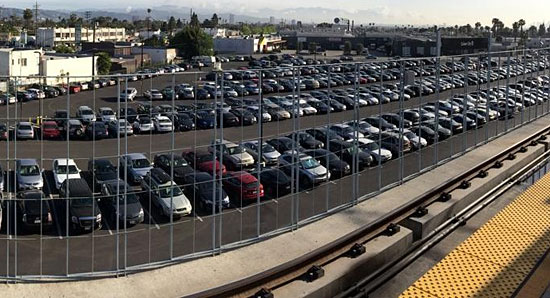
It's also tough to find a parking space at the Expo Line's Culver City station. Photo/Streetsblog LA
Posted 6/25/14
Magic in the muck
June 19, 2014
John Harris loves the smell of asphalt in the morning. As chief curator of the county’s Page Museum at the La Brea Tar Pits, he’s been enjoying the pungent smell since 1980. “I open the door of the car, and I’m here,” he said, demonstrating his appreciation with a dreamy sniff.
Not everyone shares his olfactory pleasure. “It sure smells,” observed a little boy in a baggy yellow T-shirt as he checked out some of the famous black ooze before heading into the museum with his family.
Individual noses notwithstanding, there’s a sweet smell of progress around the iconic tar pits these days. The famous mammoth and mastodon statues by the bubbling lake bed have been spiffed up and, more significantly, two scientific hot spots on the museum campus have been reactivated so that the public can get a sense of the discoveries being made each day right beside busy Wilshire Boulevard.
Beginning June 28, the mid-century Observation Pit—a repository for large Ice Age fossils from throughout the tar pit area—will become a highlight of the museum’s new Excavator Tour, after being closed since the mid-1990s. At the same time, Pit 91 is now open for excavation and public viewing after a seven-year hiatus.
The re-opened sites promise to be tourist attractions, educational resources and must-see stops on any fossil geek’s itinerary. They also mean new jobs. The museum has hired two new excavators for Pit 91. In addition, two new gallery interpreters will lead tours and five new guest relations staffers have been added.
Museum officials said the Observation Pit was closed for many years to allow excavators to concentrate their attention on the very productive Pit 91, site of such key finds as the first confirmed piece of a very young mammoth. But the excavation of Pit 91 eventually ceased because of another treasure trove of fossils uncovered in 2006 during construction of the Los Angeles County Museum of Art’s subterranean parking lot. Page Museum officials decided to focus excavation resources on the new finds, the most renowned of which was a mammoth nicknamed Zed. That ongoing effort is named Project 23 after the number of crates of specimens uncovered there.
Re-opening the Observation Pit and Pit 91 seemed like a good way to give visitors a different vantage point for exploring the museum’s collection, said Jane Pisano, president and director of the Natural History Museum of Los Angeles County, which oversees the Page.
“We have a very exciting opportunity here to preserve the tar pits for present and future scientific discoveries and at the same time do a much better job for our visitors connecting the work outside with what’s on display inside the Page Museum,” Pisano said.
She added that the new exhibits offer a window into the latest scientific thinking on what fossils can teach us. The bottom line: size matters. Smaller is better for examining changes in the environment, including climate change. While it may be sexier to find a big cat or mastodon, “the reason to focus on the smaller fossils is that those critters lived here year round,” Pisano said. “We know the bison and larger animals were migrating and only came here once in a while.”
As chief curator Harris put it: “The real emphasis now is not on the big fossils, because we’ve learned pretty much what we can. Now it’s the smaller fossils and what they can tell us.”
Officials unveiled the new attractions today. Supervisor Zev Yaroslavsky said it’s all part of a virtuous cycle of education and inspiration.
“The more access that people have to the tar pits, the more their curiosity gets piqued. The more their curiosity gets piqued, the better our quality of life is. And one or two of those kids who come here may become scientists who ultimately work for the Natural History Museum, analyzing what’s found underneath these properties,” Yaroslavsky said.
The reactivated exhibits at the tar pits are part of a Miracle Mile boom that includes extending the Purple Line subway and creating a new building at the Los Angeles County Museum of Art, to be designed by renowned architect Peter Zumthor.
“This part of Los Angeles…is on a roll,” Yaroslavsky said. “We are very excited about the future as much as we are curious about the past.”
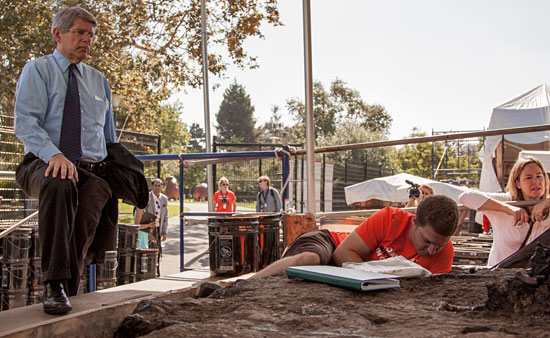
Yaroslavsky checks out some of the fossil excavation efforts taking place on the grounds of the tar pits.
Posted 6/19/14
Voting’s future: #FixIt
June 19, 2014
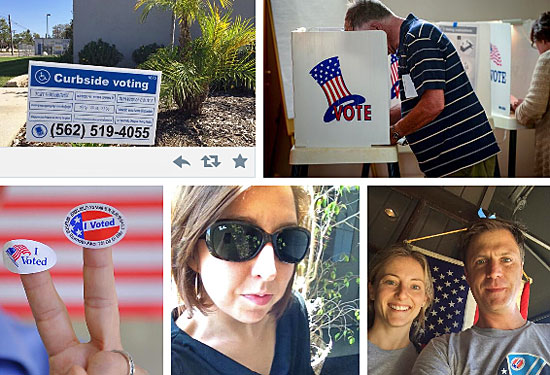
The #LAVote Twitter feed was busy on Election Day, sharing updates and photos from around the county.
After Tuesday’s primary election, Los Angeles County Registrar-Recorder/County Clerk Dean Logan noted the irony of his role the night before: He was using new technology—that is, tweeting—to explain to voters why the county can’t post instant election results on the Internet.
One of his tweets, also posted on the Registrar-Recorder/Clerk’s website : “L.A. County covers a large geographic area. It will take time for secure transport of ballots to HQ (that’s headquarters in Norwalk) for tabulations.”
During the evening, Logan and other county officials kept the Twitter generation entertained with updates and photos of bright red boxes of paper ballots security-sealed and ready for transport. Logan loves the real-time dialogue with constituents, but pleads for patience from those among the county’s 4.8 million registered voters who may blame reporting delays on county staff.
Secure transport of ballots doesn’t begin until the polls close. “Once that’s done, the counting process is fast — but we have to get them to Norwalk,” he said. (Still, as of Wednesday, thousands of “provisional” and last-minute absentee ballots remained to be counted.)
Both tired and exhilarated on Wednesday morning, Logan said it might be a long time before voters can cast their vote online or get instant election results. That’s hard to explain to a public that’s used to doing everything online, from paying bills to voting for the next American Idol.
“What it really comes down to is the value of the history of the secret ballot,” Logan said. He explained that while an online activity such as banking is a secure transaction, it still requires that the identity of the individual be linked to the account so the bank knows who you are. At the polls, the voter signs in so he or she can’t vote more than once, but once the paper ballot is placed in the box it can no longer be connected to any individual voter.
But Logan is more confident that the county can streamline the current voting process to better serve the demands of a new generation of voters in other ways. “We’re looking at modernizing the voting systems,” he said. Tuesday’s startlingly low voter turnout, he said, is one more indicator of a voting process that is “at the end of its life cycle.” (Only 13.1% of eligible county residents voted, the lowest turnout in the state.)
Last year, the county launched a massive updating of the voting apparatus to be more user-friendly, with updated equipment to be available at the polls in 2016, part of a broader effort that includes research into the future needs of an increasingly large and complex population.
And on Wednesday, the county passed an ordinance—initiated by Supervisor Zev Yaroslavsky —that will require candidates to file their campaign finance reports electronically, with the goal of eliminating the slow, labor intensive data entry process and providing quicker, more complete access to the public.
By the November 4 general election, Logan said, campaign donor information will be available online for all candidates. While optional electronic filing has existed for several years, he said, only 50% of L.A. County candidates have been filing online. Some information was only accessible on paper at Norwalk headquarters.
“And some candidates have done a hybrid, sometimes electronically, sometimes paper,” he said. “The first step is to make that an even playing field. All of the candidates will be filing in the same manner.”
He adds that it’s not enough to post campaign finance information: the county plans to make sure it’s presented in a searchable, user-friendly format. (One minor downside: Because the information will be entered online by the candidate’s campaign management, errors or violations will be publicly visible before the county has a chance to see the entry and notify the campaign of the problem.)
Logan called the move significant because “it’s one step in updating the whole process.” The goal of the county, he asserts, is “transparency, security and accountability.”
Logan said his department also is looking at new ways to bring younger voters to the polls, including the opportunity to vote at any polling place, rather than having to make it to a designated polling location during voting hours.
And the poll worker pool needs to be expanded beyond the current demographic, which skews heavily toward older people and retirees. “There is not the population available that’s willing to put in a day’s work for what is essentially a civic volunteerism act,” he said. “Some do it for the stipend, which I think is $175, but there are certainly areas of this county where that’s not an incentive.”
Logan says the department will carefully consider each update to the system. “People are now used to getting information on a real-time basis and our system isn’t designed for that,” he acknowledged. “But we need to make sure we’re not duplicating [problems] with a newer version of the old process. We need to make sure there’s value added, and a flexibility to change with the times.”
Posted 6/5/14
A stowaway on Expo 2
June 18, 2014
I had a chance to ride the rails last week, going behind the scenes of one of L.A.’s most eagerly anticipated transit projects.
The vehicle transporting me was a bouncing truck, not a sleek light rail train. But my imagination was moving full speed ahead as I traveled a major chunk of the Expo Line Phase 2 route now taking shape beside the 10 Freeway. (I even shot some iPhone footage along the way. I’m probably not going to be winning any cinematography Oscars, but I hope you’ll click on the above link to share a condensed and accelerated video version of my off-road voyage.)
When completed next year, and opened to the traveling public in 2016, Expo will be an urban transportation godsend: a chance to bring some predictability and personal choice back to what’s become, over the past decade, the increasingly soul-crushing experience of just trying to get across town.
I was moved—and not only in the literal sense—to see all the years of hard work, planning and construction transforming into something so real and so powerful. The long-held dream of being able to make it from downtown L.A. to 4th Street in Santa Monica in 46 minutes flat is now emerging fast from steel, sweat and stone.
I saw stations rising in Palms and at Westwood Boulevard. Long stretches of sound walls were already in place. About four miles of track have been installed, with 10 additional miles coming soon to complete the roundtrip journey of Expo Phase 2 from Culver City to Santa Monica.
On the morning of my off-road tour, from Bagley Avenue to Military Avenue in West Los Angeles, electrical crews were racing their construction counterparts to put up the network of power poles that will move Expo’s trains. Knots of workers were busily installing pavers on the platform of the Westwood Boulevard station. Elevator towers were up at the Palms Station, ready for the contractor to install glass and machinery. And heavy, laser-equipped machines were preparing to tamp down rock ballast between rail ties.
It was a fascinating trip into L.A.’s past, present and future. We traveled past the modern Lycée Français de Los Angeles; past an area known as Motor Yard where generations of taggers, unfortunately, have left an inch-thick residue of graffiti for our teams to clean up; through an old freight train tunnel under the 10 Freeway that will soon see a new generation of trains gliding through.
To our right, for some of the trip, rumbled the 10 Freeway—moving uncharacteristically smoothly on this morning but inevitably heading toward the gridlock that will be the Expo Line’s best advertisement when Phase 2 opens. As we passed the Westwood Boulevard station, another symbol of motoring frustration, the 405 Freeway, was visible to the west.
It was an amazing vantage point, and I wish that every Angeleno who’s ever cursed a Sig Alert could have been along for the ride. Short of that, I hope that the video above will spur your imagination and awaken the sense that something better is coming down the tracks for Los Angeles.
Posted 6/18/14




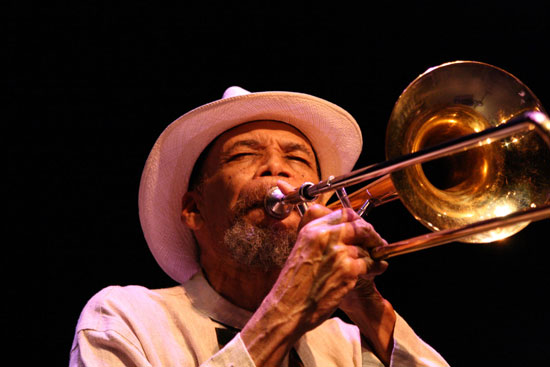
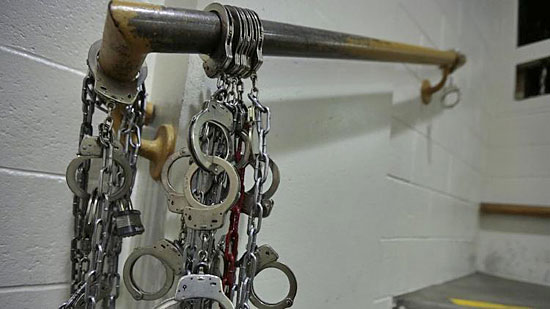
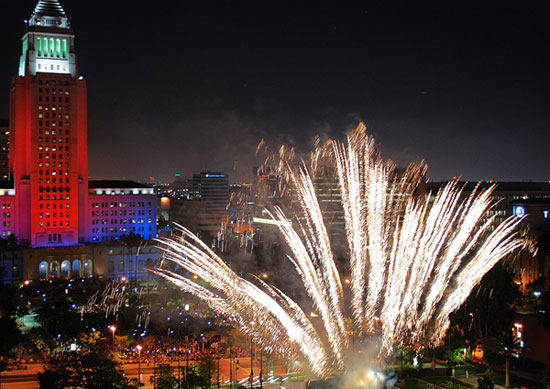
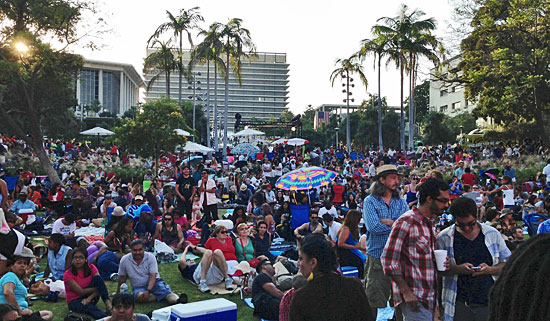
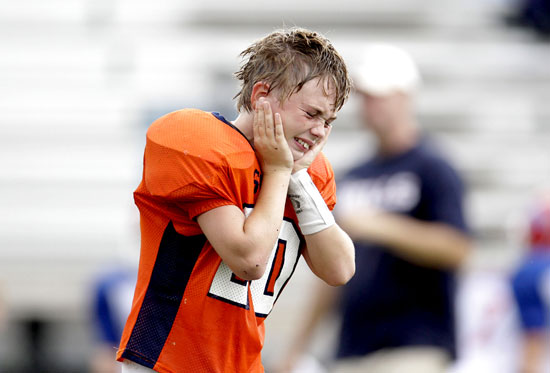
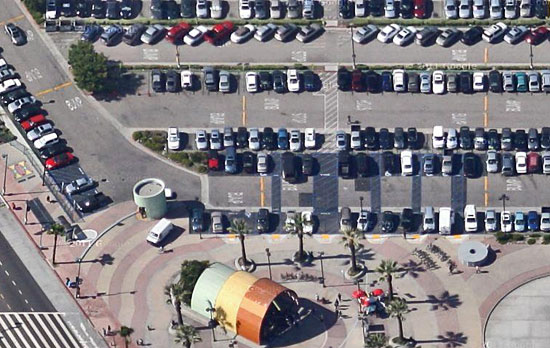
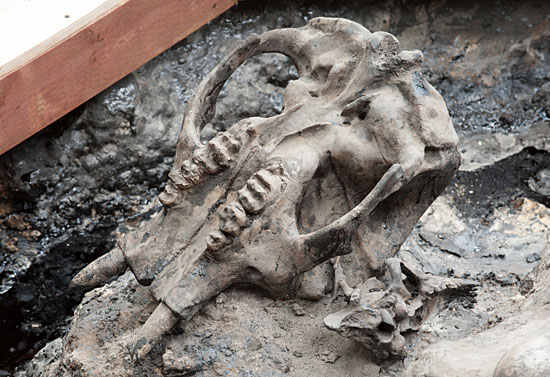
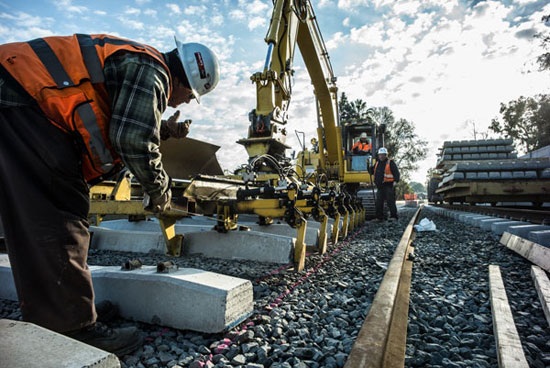





 Check for the latest closure information
Check for the latest closure information








